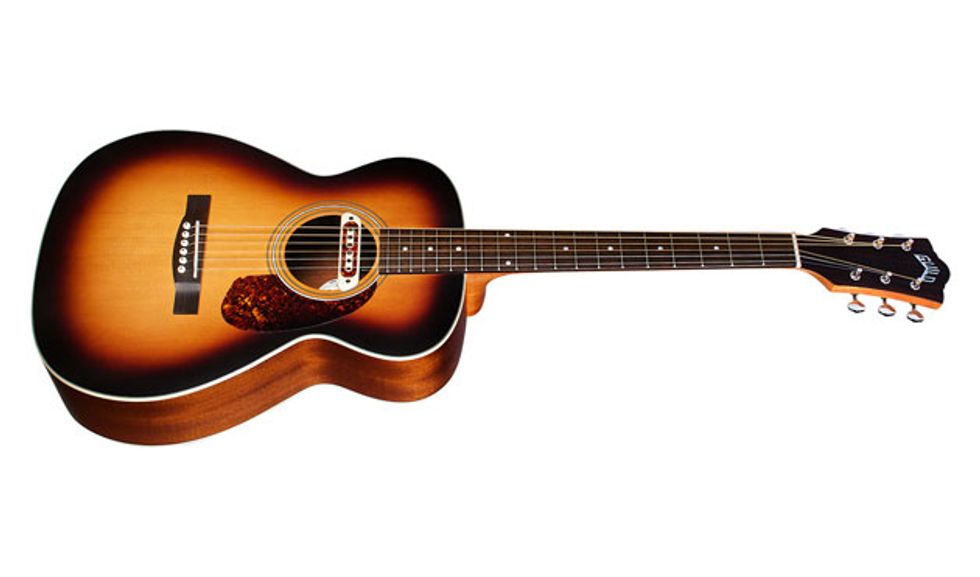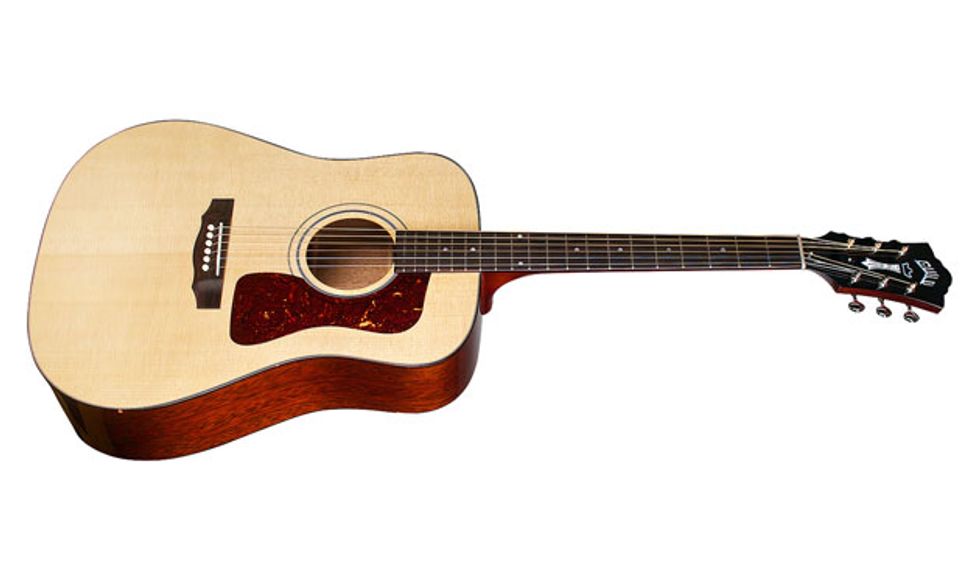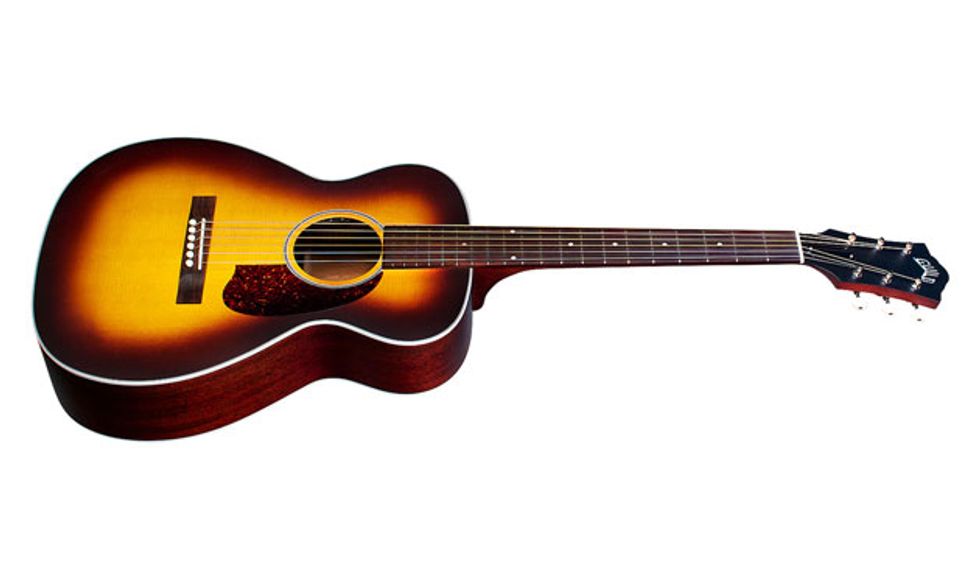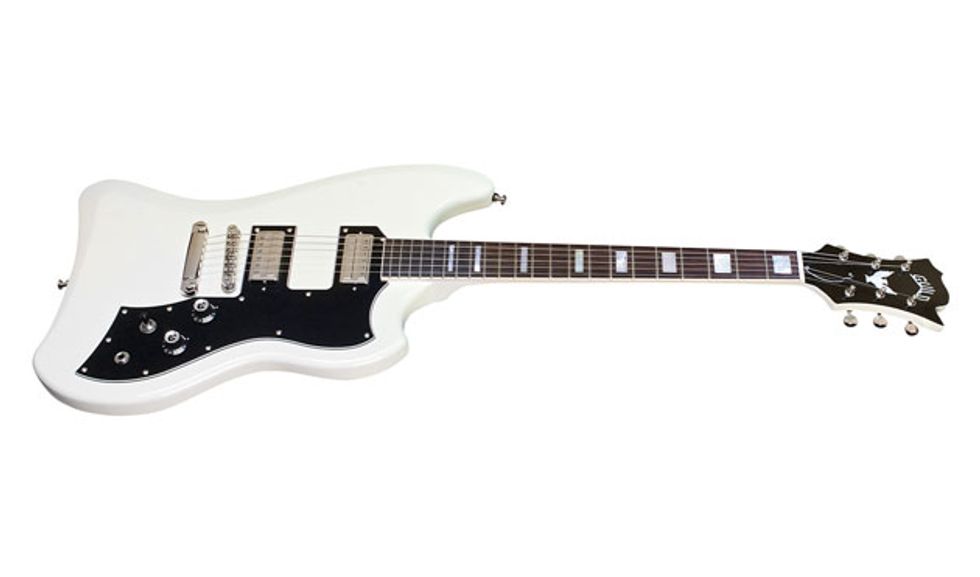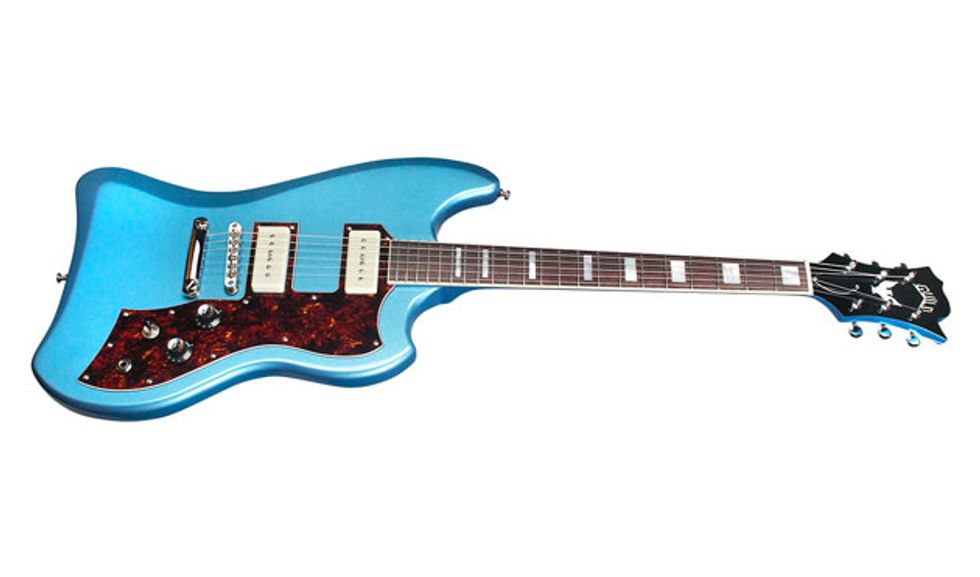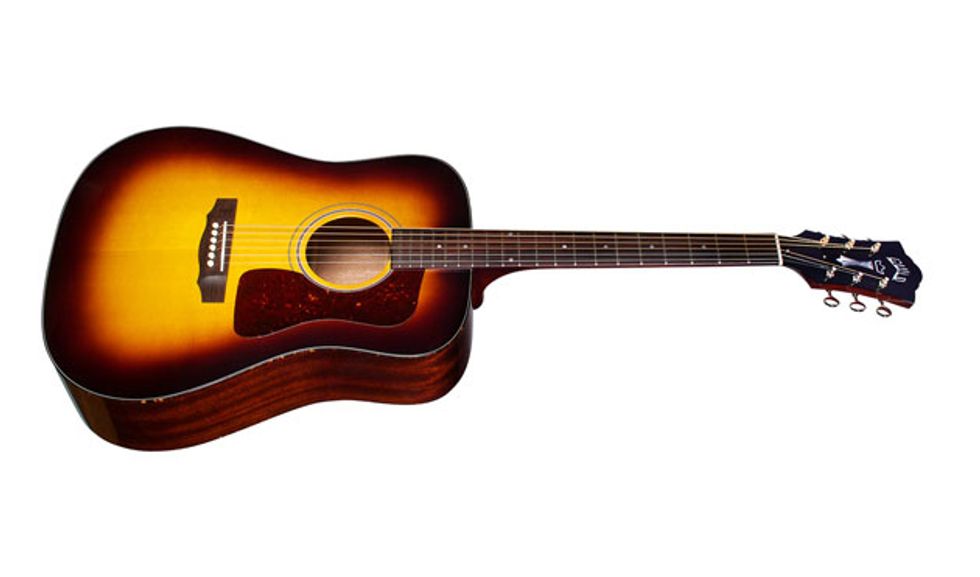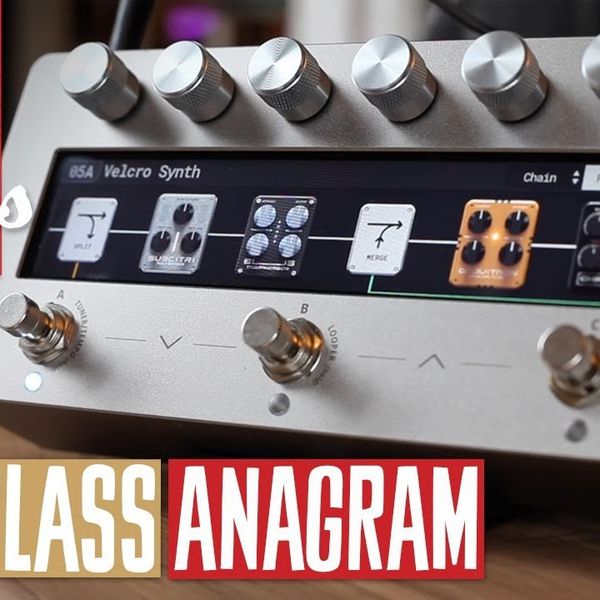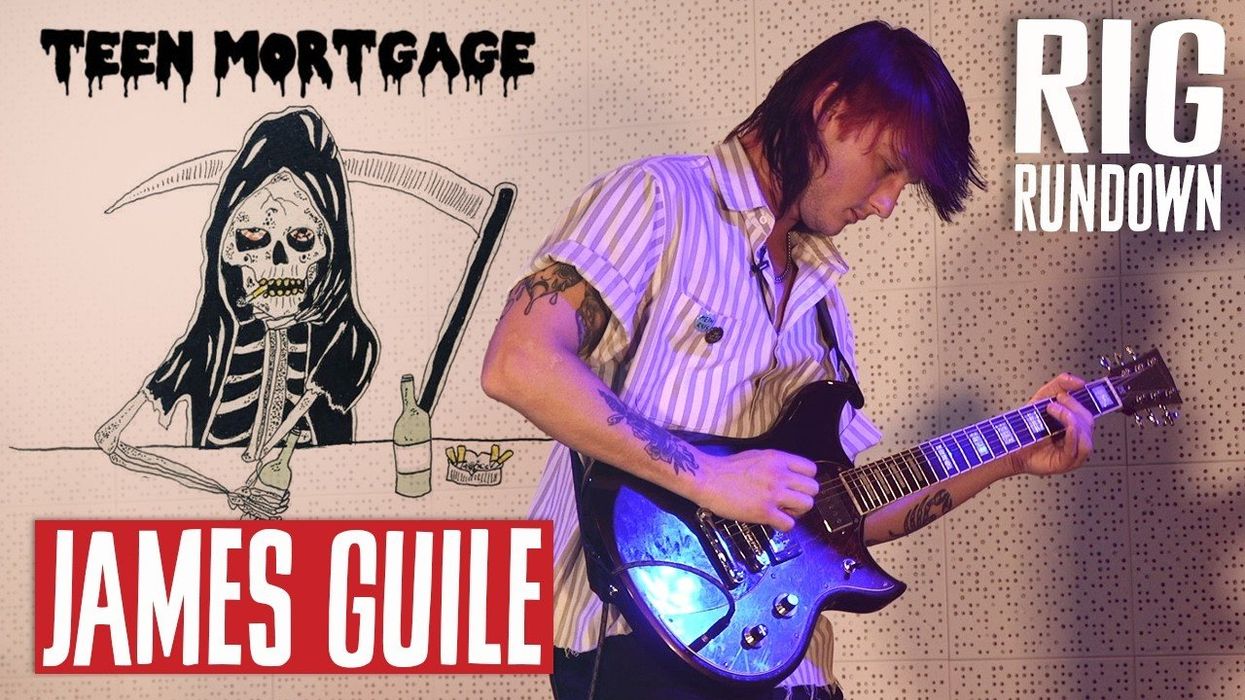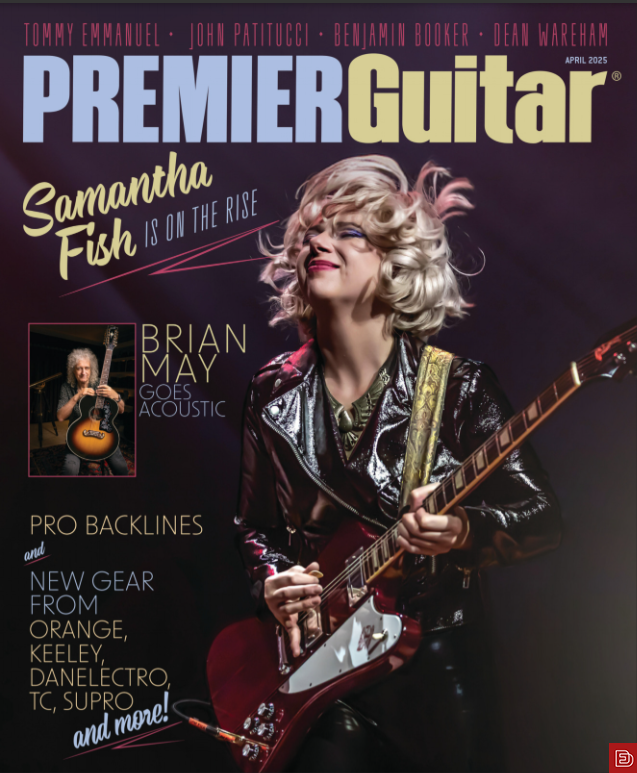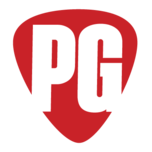Back after a two-year hiatus is the D-55, Guild's flagship dreadnought acoustic.
Santa Monica, CA (January 17, 2017) -- Nearly three years after moving USA manufacturing from Connecticut to a new factory in Oxnard, California, Guild is proud to resume production of its most iconic dreadnought model, the D-55. First introduced in 1968 as a special-order top-of-the-line model, the D-55 was so well-received that Guild added it into the regular production line by 1974. Famously played by Tommy Smothers on the Smothers Brothers Show in the 1960s, the D-55 grew in both popularity and longevity over the decades, finding homes in the hands of more contemporary artists like Waylon Jennings, Billie Joe Armstrong, and David Nail. The most anticipated return of a Guild acoustic to date, the 2017 Guild D-55 is back and better than ever.
The D-55 remains true to all the premium appointments of its 1968 predecessor, including a AAA Sitka spruce top, solid Indian Rosewood back and sides, ebony fingerboard and bridge, and nitrocellulose finish. Internal refinements include scalloped Adirondack bracing designed by master luthier Ren Ferguson, as well as an improved dovetail neck-joint, hand fit to make this generation of D-55 the lightest, loudest, and best-sounding yet. “We’re very proud of the guitars we’re now making here in the USA,” says President Jonathan Thomas. "They sound like beautiful worn-in Guilds from the 60s, and are so comfortable to play. Everyone can’t believe how responsive and light they are while still maintaining that huge classic Guild tone...and the D-55 has always been such gorgeous guitar. The aesthetics are a beautiful mix of premium woods and abalone and mother-of-pearl inlay work. It really represents the top of our USA craftsmanship.”
The D-55 showcases Guild's most recognizable headstock which is fully bound and features the Guild “Peak and G-shield” inlay combination over a figured ebony overlay. The matching ebony fingerboard is also fully bound and inlayed with Guild’s iconic abalone/pearl “V-Blocks” and multi-line “railroad track” purfling on the bass and treble sides. The D-55’s fingerboard is set on an all-mahogany neck with beautiful walnut center seam running the length of the heel to headstock.
The D-55's nitro finish is available in natural or Antique Burst and is hand sprayed for minimum thickness and maximum resonance that will only get better with age. An LR Baggs pickup system is available as an option, and each guitar includes a had signed certificate of authenticity and ships Guild's Premium humidified hardshell case.
The D-55 Line-Up:
D-55 in Natural - Street $3,299.99
D-55 in Antique Burst - Street $3,399.99
D-55E in Natural - Street $3,499.99
D-55E in Antique Burst - Street $3,599.99
Building upon the smash hit of the S-200 T-Bird reissue, Guild has announced two new T-Bird ST models, featuring the same unique, asymmetrical shape, but with a simplified feature sets. Minimalist players will appreciate the added stability and reliability of a stopbar tailpiece and pared down electronic controls, while enjoying the T-Bird's retro vibe.
The T-Bird ST's dual LB-1 Little Bucker pickups are replicas of Guild’s 1960s smaller size humbucking pickups, offering a range of tones well-suited for a variety of playing styles and genres. The dual Guild Franz P90 pickups found on the T-Bird ST P90 are perfect for the player looking for that crisp, vintage, single-coil sound, offering plenty of mid-range output that can be driven to a soaring classic rock tone.
Both models feature vintage C shape set mahogany necks, and bound rosewood fingerboard with mother-of-pearl block inlays. Other period-correct details include open gear vintage tuning machines, and famed asymmetrical headstock adorned with Guild’s logo and Thunderbird icon in mother-of-pearl. The T-Bird ST is available in a classic Vintage White, while the T-Bird ST P90 comes in Pelham Blue. A padded Guild deluxe gig bag is included.
T-Bird Line-Up:
S-200 T-Bird Antique Burst: Street $849.99
S-200 T-Bird Black: Street $849.99
T-Bird ST: Street $799.99
T-Bird ST P90: Street $799.99
In the 1960s folk-era, Guild built concert-sized spruce/mahogany guitars, lovingly dubbed “Troubadours” for their travel-friendly size and weight and popularity amongst singer-songwriters. These qualities are still sought-after today by a new generation of musicians and Guild is pleased to once again offer these features with the addition of the M-240E Troubadour and the USA-made M-40 Troubadour.
The affordable M-240E Troubadour features a solid mahogany top, and Guild's signature arched mahogany back, allowing for great volume and projection, long sustain, and a lush, full sound. Ready for the stage or studio, the M-240E's understated yet powerful DeArmond ToneBoss magnetic pickup makes its debut. The combination of a soft satin antique burst finish with a soundhole pickup give the M-240E Troubadour an overall retro vibe.
Guild's USA-made Troubadour, the M-40, features all-solid woods and provides a delicate, well-rounded tone that is perfect for fingerstyle playing and light strumming. Premium features include white ABS binding, Indian rosewood bridge and fingerboard, and bone nut and saddle. A thin satin varnish gives this guitar its familiar, broken-in look and feel, while also allowing it to breathe. This model is available in Natural or Antique Burst and includes the option of a discreet, USA-made LR Baggs Element VTC pickup.
Troubadour Line-Up:
M-240E Troubadour: Street $469.99
M-140: Street $749.99
M-140E: Street $849.99
M-40 Troubadour: Street $1,599.99 - $1,699.99
M-40E Troubadour: Street $1,799.99 – $1,899.99
Guild is proud to kick off 2017 with a full USA-made acoustic lineup ranging from $1,299 - $3,599 MAP. Continuing upon the success of Guild's M-20, D-20, and D-40, Guild is excited to elevate its acoustic offerings with the M-40 Troubadour (formerly the F-20), the D-40 Traditional, and finally the highly anticipated D-55.
The M-40 Troubadour's solid Sitka spruce top and solid African mahogany back and sides offer a different tone when compared to Guild's iconic “Nick Drake guitar,” the all-mahogany M-20, which made its debut at Winter NAMM 2016. Available in a satin finish with a white ABS binding, the M-40 Troubadour is ideal for fingerstyle playing and light strumming. Its concert size is excellent for players who prefer a slightly smaller body.
The D-40 Traditional (also solid spruce/mahogany) adds premium appointments to Guild's dreadnought Summer NAMM 2016 release, the D-40. These include a dovetail neck joint, tortoiseshell binding, a heritage chesterfield MOP inlaid logo on the headstock, and a nitrocellulose gloss finish.
Lastly, back after a 2-year hiatus is the D-55, Guild's flagship dreadnought acoustic. First introduced in the late 1960s, the D-55 featured a solid Sitka spruce top and solid Indian rosewood back and sides. Guild's 2017 D-55 keeps all of the same exceptional embellishments as its predecessor such an abalone rosette, MOP/abalone fingerboard inlays, and a mother-of-pearl Guild “Peak and G-Shield” logo on a flamed ebony headstock overlay. Internally, a modern dovetail neck-joint and Adirondack spruce braces refined by master luthier Ren Ferguson make this generation of D-55s the lightest, loudest, and best yet.
All Guild USA models are available in Natural or Burst with an optional LR Baggs Element VTC pickup. Shipping in hardshell humidity-controlled cases, these models include a signed certificate of authenticity. “We began this journey in 2014 and we've come a long way since then,” says Guild CEO Tim Miklaucic. “Resuming production of the D-55 is monumental for continuing Guild's legacy. We're building the best Guild acoustics to date and doing it in California—it doesn't get any better than that.”
Guild USA Line-Up:
M-20: Street $1,299.99 - $1,399.99
M-20E: Street $1,499.99 - $1,599.99
D-20: Street $1,299.99 - $1,399.99
D-20E: Street $1,499.99 - $1,599.99
M-40 Troubadour: Street $1,599.99 - $1,699.99
M-40E Troubadour: Street $1,799.99 - $1,899.99
D-40: Street $1,599.99 - $1,699.99
D-40E: Street $1,799.99 - $1,899.99
D-40 Traditional: Street $2,399.99 - $2,499.99
D-55: Street $3,299.99 - $3,399.99
D-55E: Street $3,499.99 - $3,599.99
For more information:
Guild Guitars
$149
Marshall 1959 Super Lead
The very definition of classic, vintage Marshall sound in a highly affordable package.
There’s only one relevant question about Marshall’s new 1959 Super Lead overdrive/distortion pedal: Does it sound like an actual vintage Super Lead head? The answer is, simply and surprisingly, yes. The significant difference I heard within the voice of this stomp, which I ran through a Carr Vincent and a StewMac Value Factory 18 kit amp for contrast, is that it’s a lot quieter than my 1972 Super Lead.
The Super Lead, which bore Marshall’s 1959 model number, debuted in 1965 and was the amp that defined the plexi sound. That sound is here in spades, clubs, diamonds, and hearts. Like the Super Lead, the pedal is easy to use. The original’s 3-band EQ is replaced by a single, rangeful tone control. The normal dial and the volume, which together mimic the character created by jumping the first and second channels of a plexi head, offer smooth, rich, buttery op-amp driven gain and loudness. And the high-treble dial functions much like the presence control on the original amp.
The pedal is sturdy and handsome too. A heavy-duty metal enclosure evokes the classic black-with-gold-plate plexi look and a vintage-grille-cloth motif. Switches and knobs (the latter with rubber sides for slip-free turning) are ultra solid, and–refreshingly–there’s a 9V battery option in addition to a barrel-pin connection. Whether with single-coils or humbuckers, getting beefy, sustained, historic tones took moments. I especially delighted in approximating my favorite Super Lead head setting by flooring the high treble, normal, and tone dials, and turning back the tone pots on my Flying V, evoking Disraeli Gears-era Clapton tone. That alone, to me, makes the 1959 Super Lead stomp a bargain at $149.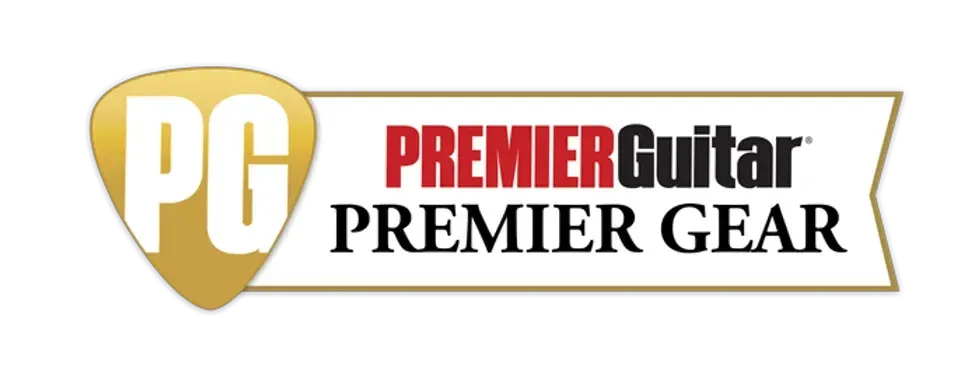
Two guitars, two amps, and two people is all it takes to bring the noise.
The day before they played the coveted Blue Room at Third Man Records in Nashville, the Washington, D.C.-based garage-punk duo Teen Mortgage released their debut record, Devil Ultrasonic Dream. Not a bad couple of days for a young band.
PG’s Chris Kies caught up with guitarist and vocalist James Guile at the Blue Room to find out how he builds the band’s bombastic guitar attack.
Brought to you by D’Addario.
Devilish Dunable
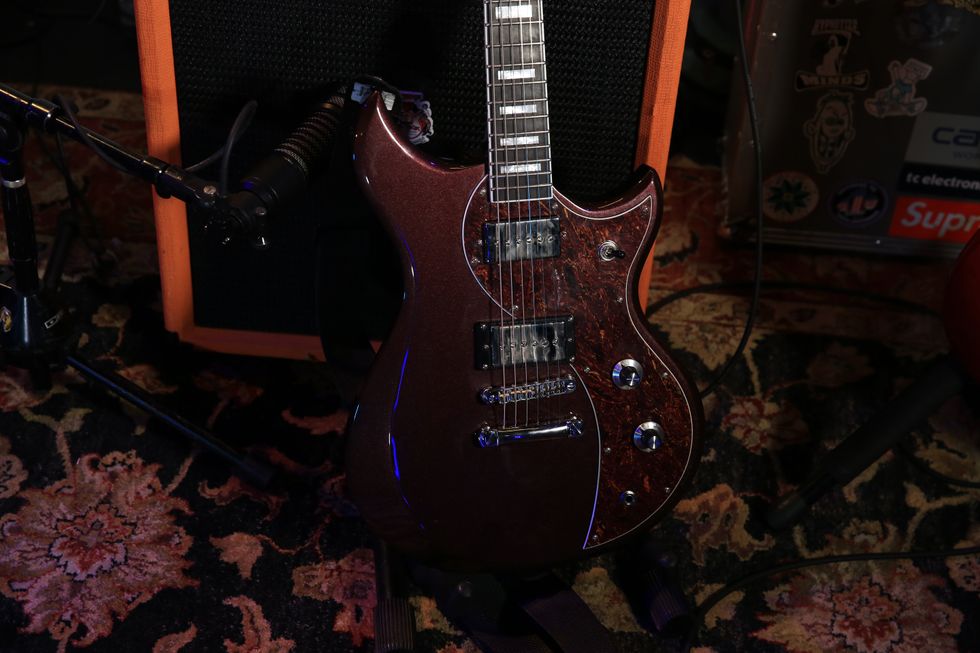
Guile has been known to use Telecasters and Gretsches in the past, but this time out he’s sticking with this Dunable Cyclops DE, courtesy of Gwarsenio Hall—aka Jordan Olds of metal-themed comedy talk show Two Minutes to Late Night. Guile digs the Dunable’s lightness on his shoulders, and its balance of high and low frequencies.
Storm Warning
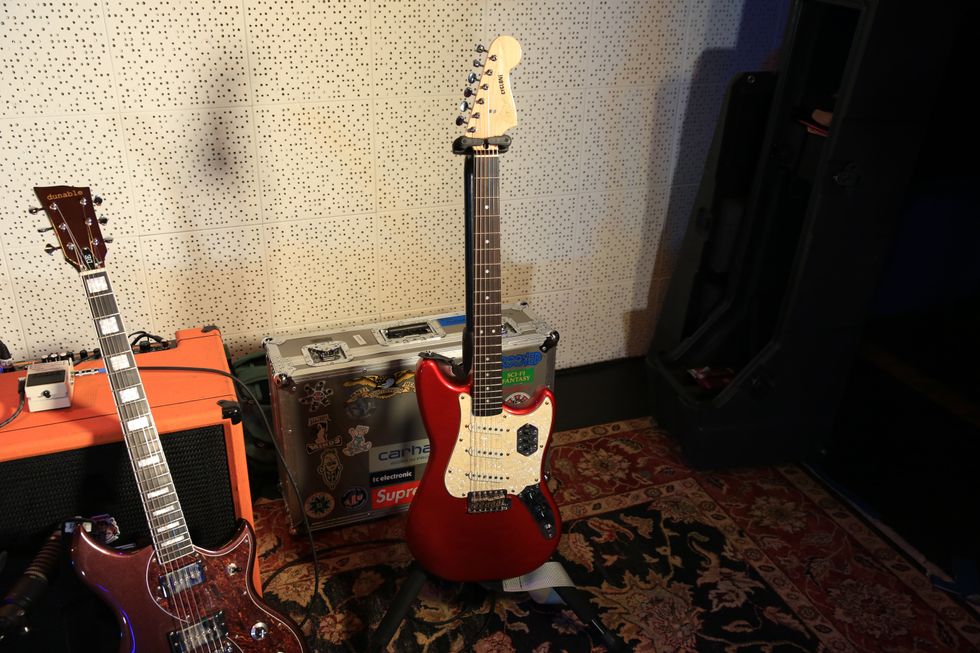
What does Guile like about this Squier Cyclone? Simple: its color. This one is also nice and easy on the back, and Guile picked it up from Atomic Music in Beltsville, Maryland.
Crushing It
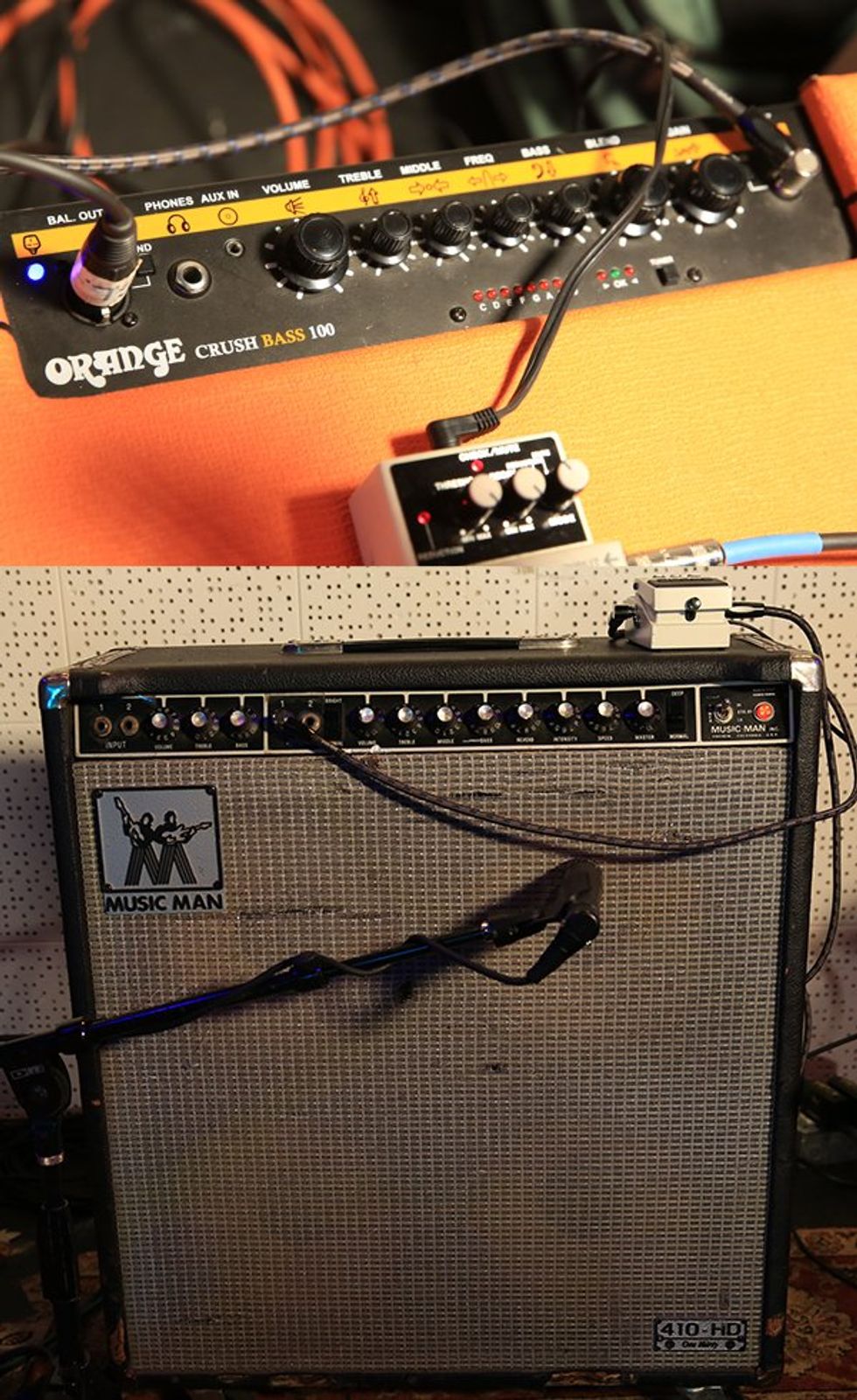
Guile also scooped this Music Man 410-HD from Atomic, which he got just for this tour for a pretty sweet deal. It runs alongside an Orange Crush Bass 100 to rumble out the low end.
James Guile’s Pedalboard
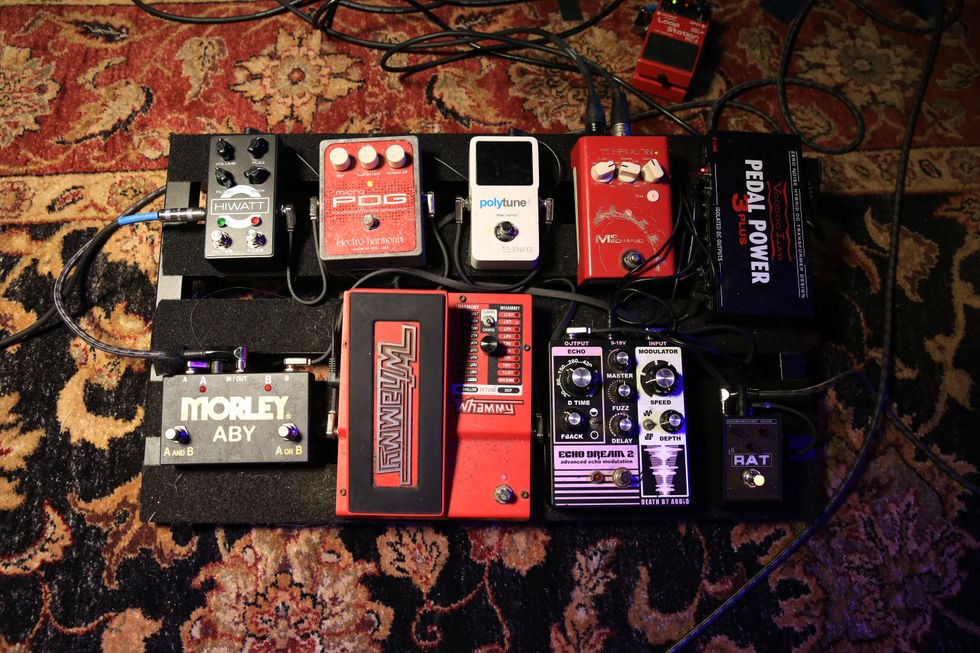
The Electro-Harmonix Micro POG and Hiwatt Filter Fuzz MkII run to the Orange, while everything else—a DigiTech Whammy, Pro Co Lil’ RAT, and Death by Audio Echo Dream 2—runs to the Music Man. A TC Helicon Mic Mechanic is on board for vocal assistance, and a TC Electronic PolyTune 3, Morley ABY, and Voodoo Labs Pedal Power 3 Plus keep the ship afloat.
Ernie Ball, the world’s leading manufacturer of premium guitar and bass strings, is proud to announce the release of the Pino Palladino Signature Smoothie Flats, the newest innovation in flatwound bass strings.
Developed in collaboration with legendary bassist Pino Palladino, these signature sets are engineered to deliver an ultra-smooth feel and a rich, warm tone that’s as versatile as it is expressive. Available in two gauges—Extra Light (38–98) and Medium (43–108)— Smoothie Flats are crafted with a precision-polished cobalt alloy ribbon for low tension, flexible playability, and deep vintage-inspired sound.
Ernie Ball: Pino Palladino Signature Smoothie Flats Bass Strings
Product Features:
- Precision polished for an ultra-smooth feel
- Cobalt alloy ribbon winding for a rich, deep sound
- Flexible, low-tension design for superior playability
- Trusted by Pino Palladino for studio and live performance
Pino Palladino Signature Smoothie Flats bass strings are available at Ernie Ball dealers worldwide.
Cool compression profile that yields blooming and nasty fuzz with fangs. Simple. Excellent value!
Not a ton of variation in the fuzz’s simple controls.
One big, bad, and very boss no-frills fuzz.
On the surface, fuzz is an almost barbarian concept—a nasty sound that’s easy to grasp in our imaginations. But contrast David Gilmour’s ultra-creamy Big Muff sounds with James Gurley’s free and visceral fuzz passages from Big Brother and the Holding Company’s Cheap Thrillsand you remember that two different fuzzes, in the hands of two different players, can speak very different languages. The latter artist concerns us here because Gurley did his work with a Jordan Boss Tone, which is the inspiration for the Ananashead Spirit Fuzz.
Ananashead’s Pedro Garcia has a knack for weirder 1960s fuzzes. HisMeteorite silicon Fuzzrite clone, for instance, is a knockout. This take on the two-transistor Boss Tone is equally thrilling, and genuinely idiosyncratic when it runs at full tilt. It exhibits tasty inherent compression, and transient notes ring out as pronounced and concise before blooming into full viciousness—a quality that shines when paired with neck-position humbuckers (and which probably made the original circuit appealing to Spirit’s Randy California, another 1960s Boss Tone devotee). That tone profile gives the Spirit Fuzz meatiness that stands out among ’60s-style two-transistor circuits, and the sense of mass, combined with the pedal’s intrinsic focus, makes it superb for tracking. The Spirit loves humbuckers, which coax real sweetness from the circuit. But it was just as happy to take a ride with a Jaguar bridge pickup and an old Fender Vibrolux with the reverb at 10. Sounds painful, right? On the contrary, it was one of the most haunting fuzz sounds I can remember playing.

